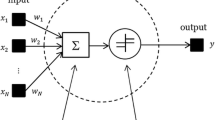Abstract
In this study, a new, model-free damage detection method is proposed and validated on a simple numerical experiment. The proposed algorithm used vibration data (deck accelerations) and bridge weigh-in-motion data (load magnitude and position) to train a two-stage machine learning setup to classify the data into healthy or damaged. The proposed method is composed in its first stage of an artificial neural network and on the second stage of a gaussian process. The proposed method is applicable to railway bridges, since it takes advantage of the fact that vehicles of known axle configuration cross the bridge regularly, that normally only one train is on the bridge at a time and that the lateral positioning of the loads does not change. The novelty of the proposed algorithm is that it makes use of the data on the load’s position, magnitude and speed that can be obtained from a Bridge Weigh-in-Motion system to improve the accuracy of the damage detection algorithm.












Similar content being viewed by others
References
Cavadas F, Smith FC, Figueiras J (2013) Damage detection using data-driven methods applied to moving-load responses. Mech Syst Signal Process 39(1):409–425
An Y et al (2014) A damage localization method based on the ‘jerk energy’. Smart Mater Struct 23(2):025020
Dackermann U, Smith WA, Randall RB (2013) Application of cepstrum analysis and artificial neural networks for the damage identification of a two-storey framed structure based on response-only measurements. Proceedings for the 6th international conference on structural health monitoring of intelligent infrastructure, Hong Kong, China, 9–11
Figueiredo E et al (2014) A Bayesian approach based on a Markov-chain Monte Carlo method for damage detection under unknown sources of variability. Eng Struct 80:1–10
Laory I et al (2013) ‘Combined model-free data-interpretation methodologies for damage detection during continuous monitoring of structures. J Comput Civil Eng 27(6):657–666
Tang Y et al (2013) A model-free damage identification method for flexural structures using dynamic measurements from distributed long-gage macro-strain sensors. J Intell Mater Syst Struct 25(13):1614–1630
Lee SG, Yun GJ, Shang S (2014) Reference-free damage detection for truss bridge structures by continuous relative wavelet entropy method. Struct Health Monit. doi:10.1177/1475921714522845
Santos JP, Cremona C, Orcesi AD, Silveira P, Calado L (2015) Static-based early-damage detection using symbolic data analysis and unsupervised learning methods. Fornt Struct Civil Eng. doi:10.1007/s117009-014-0277-3
Rowley C, O’Brien E, Gonzalez A, Zidaric A (2009) Experimental testing of a moving force identification bridge weigh-in-motion algorithm. Exp Mech 49(5):743–746
Deesomsuk Teerachai, Pinkaew Tospol (2010) Evaluation of effectiveness of vehicle weight estimations using bridge weigh-in-motion. IES J Part A 3(2):96–110
Deng Lu, Cai CS (2009) Identification of parameters of vehicles moving on bridges. Eng Struct 31(10):2474–2485
Carey Ciaran H, O’Brien Eugene J, Keenahan Jennifer (2013) Investigating the use of moving force identification theory in bridge damage detection. Key Eng Mater 569:215–222
Chen WZ, Xu J (2012) The theory and case study of axle load identification based on BWIM of orthotropic steel deck. Appl Mech Mater 204:1247–1254
Karoumi R, González A (2015) The virtual axle concept for detection of localised damage using bridge weigh-in-motion data. Eng Struct 89:26–36
Liljencrantz A, Karoumi R, Olofsson P (2007) Implementing bridge weigh-in-motion for railway traffic. Comput Struct 85(1):80–88
Ignacio G, Karoumi R (2013) Traffic monitoring using a structural health monitoring system. Proc ICE-Bridge Eng 168:13–23. doi:10.1680/bren.11.00046
Pimentel RMCD, Miguel R et al (2008) Hybrid fiber-optic/electrical measurement system for characterization of railway traffic and its effects on a short span bridge. Sens J IEEE 8(7):1243–1249
Braspenning PJ, Thuijsman F, Weijters AJMM et al (1995) Artificial neural networks: an introduction to ANN theory and practice. Springer, New York
Ko JM et al (2009) Investigation concerning structural health monitoring of an instrumented cable-stayed bridge. Struct Infrastruct Eng 5(6):497–513
Lin N, Qun C (2013) Structural health monitoring and damage detection using neural networks. Intelligent system design and engineering applications (ISDEA), 2013 3rd international conference on. IEEE
Shu J, Zhang Z, Gonzalez I, Karoumi R (2013) The application of a damage detection method using artificial neural network and train-induced vibrations on a simplified railway bridge model. Eng Struct 52:408–421
Cybenko G (1989) Approximation by superpositions of a sigmoidal function. Math Control Signals Syst 2(4):303–314
Marquardt DW (1963) An algorithm for least-squares estimation of nonlinear parameters. J Soc Ind Appl Math 11(2):431–441
Rasmussen CE, Nickisch H (2010) Gaussian processes for machine learning (GPML) toolbox. J Mach Learn Res 9999:3011–3015
Gonzales I, Ülker-Kaustell M, Karoumi R (2013) Seasonal effects on the stiffness properties of a ballasted railway bridge. Eng Struct 57:63–72
Acknowledgments
The authors are grateful for the funding provided by the Swedish Governmental Agency for Innovation Systems VINNOVA within the project IoT Bridge.
Author information
Authors and Affiliations
Corresponding author
Rights and permissions
About this article
Cite this article
Gonzalez, I., Karoumi, R. BWIM aided damage detection in bridges using machine learning. J Civil Struct Health Monit 5, 715–725 (2015). https://doi.org/10.1007/s13349-015-0137-4
Received:
Revised:
Accepted:
Published:
Issue Date:
DOI: https://doi.org/10.1007/s13349-015-0137-4




